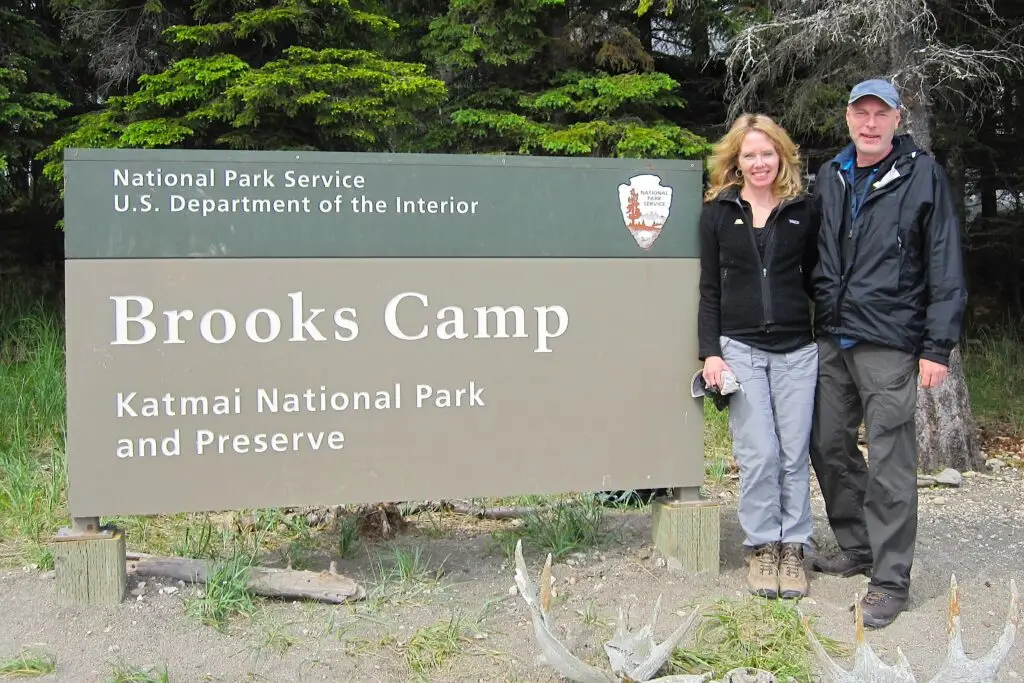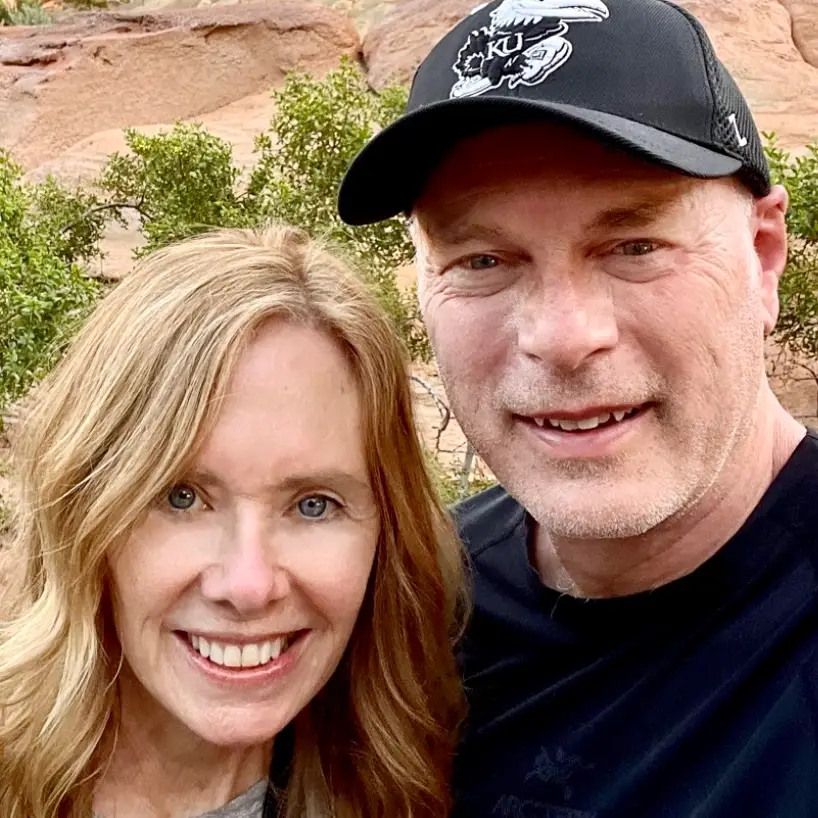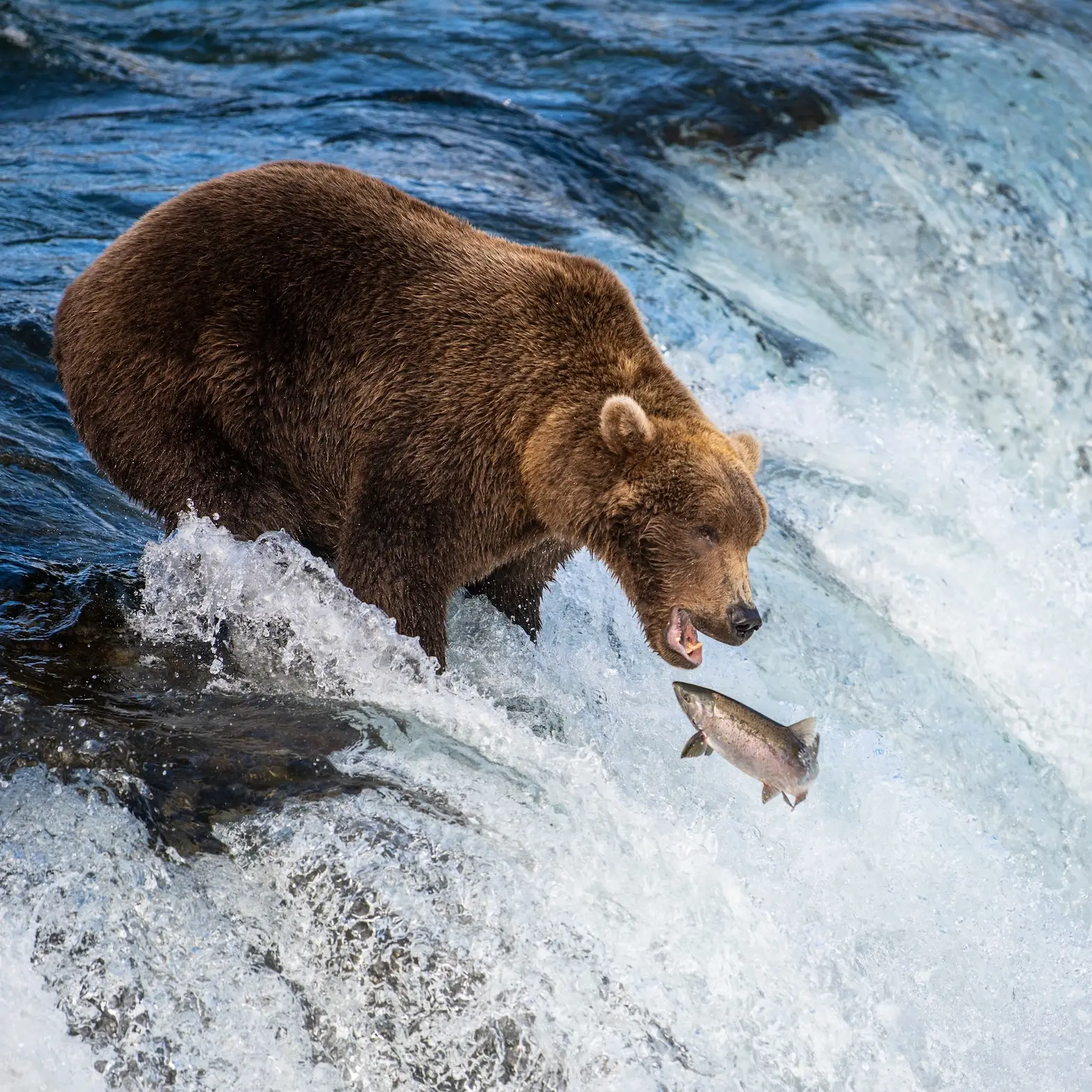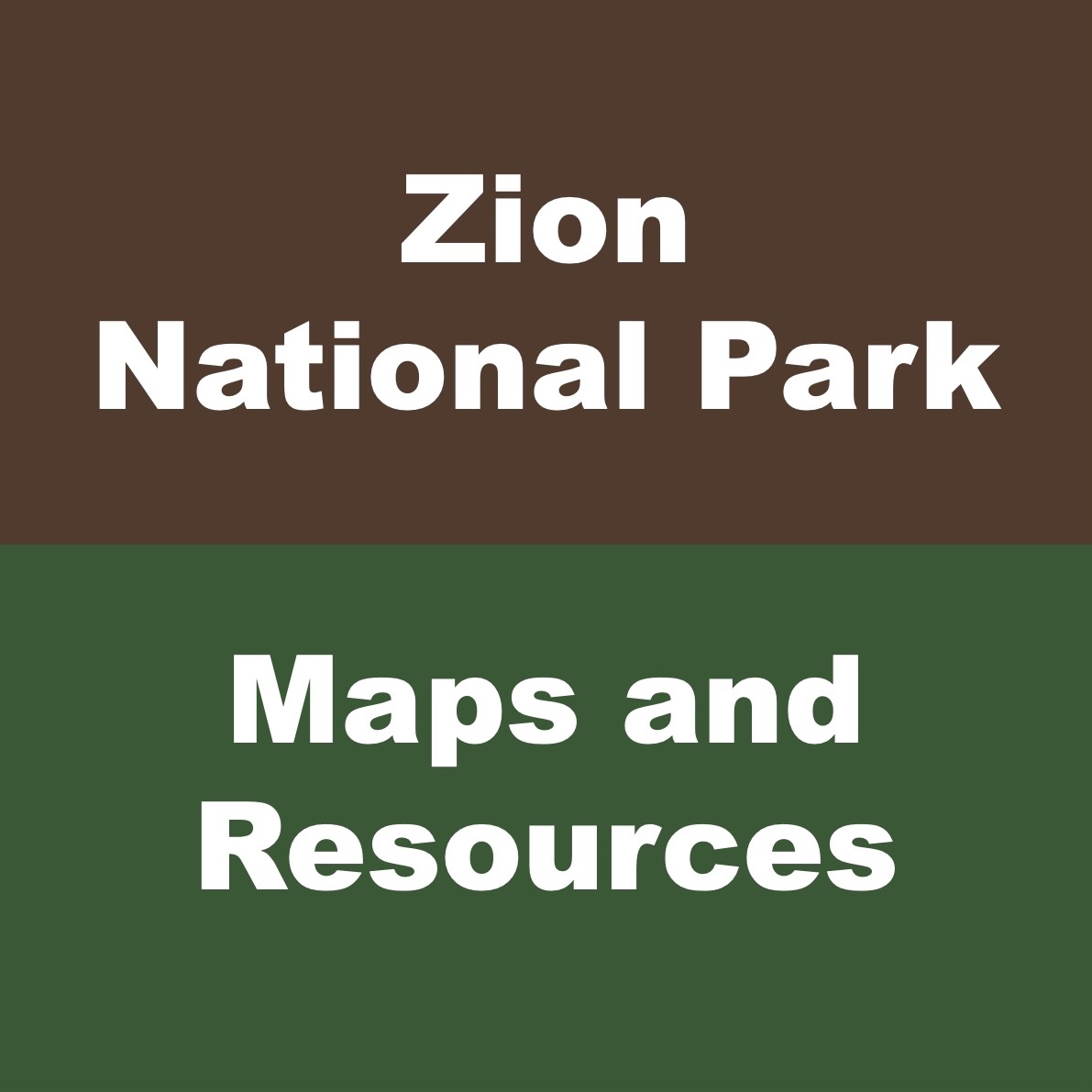Looking back on our travel to all 63 US national parks, seeing grizzly bears up close and in the wild at Katmai National Park may have been our most amazing experience. At least it was until a few days later when we were in a mid-air collision with another plane over Lake Clark National Park.
But if we focus just on our positive amazing experiences, bear viewing at Katmai takes the top spot.
After we had visited all the parks, we wrote a book titled Dear Bob and Sue about our experiences. The book was in the form of emails we sent to our friends Bob and Sue, who couldn’t join us on the trip. We asked them to, but they had more important things to do at the time, like raising kids.
This post is an excerpt from Dear Bob and Sue, our Katmai email. Katmai National Park was the 50th national park we’d visited on our quest to see them all. We hope you enjoy it.
From: Matt Smith
Subject: #50 – Katmai National Park
Date: July 8, 2011
Dear Bob and Sue,
As our floatplane banked left and dropped toward the water, the first thing we saw was a mother bear and cub. They were walking along the edge of the lake, slowly moving away from the planes that were parked tail-first in front of Brooks Camp. By the time we landed and taxied to shore, they were at a safe enough distance that we could exit the plane. We were hoping to see bears in the park; what we saw far exceeded our expectations.
This was Katmai National Park, designated a national monument in 1918 and made a national park and preserve in 1980. The park preserves the site of the still-smoldering Novarupta Volcano eruption, which blew in 1912 with the force of over ten Mount St. Helenses. The Valley of Ten Thousand Smokes – the name of the eruption site – is a popular visitor attraction, but another significant part of the park’s mandate is the preservation of its brown bear population. We came to see the bears.
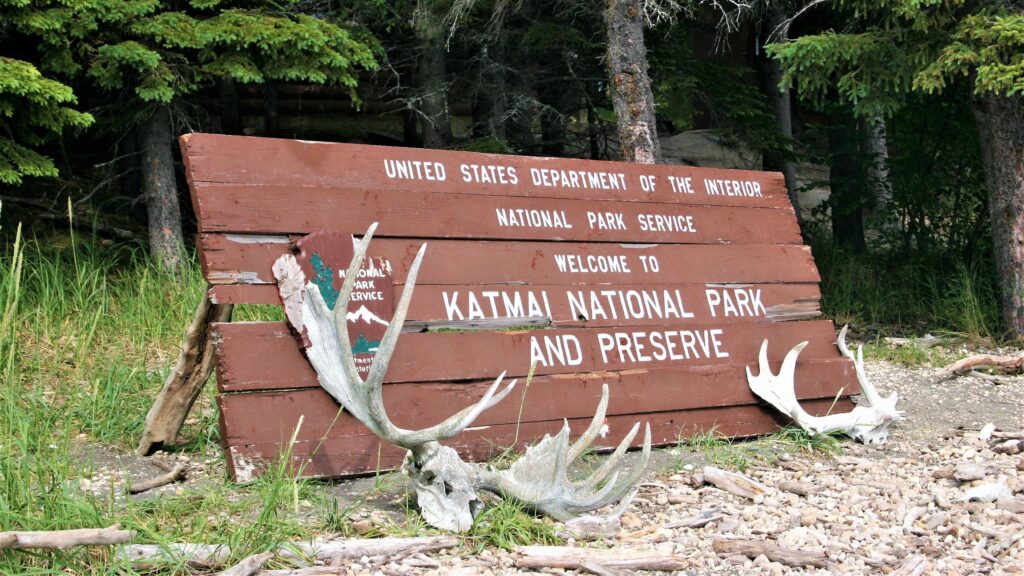
Katmai is 200 miles southwest of Anchorage, Alaska at the base of the Alaska Peninsula. It’s in the bush, meaning no roads lead to it (that is, no roads that connect to the rest of Alaska). King Salmon – a town of 500 – is a couple of miles west of the park border. Most visitors who come to see the bears and the Valley of Ten Thousand Smokes fly into King Salmon, and then take a floatplane from there to Brooks Camp. That’s how we got here.
Katmai National Park Bear School
The park service doesn’t let you jump off the plane and head off looking for bears, which was my first instinct. They required us to sit through a bear orientation at the visitor center – Karen called it bear school – before they gave us free access to the park. At the conclusion of bear school, we got pins that we were to wear at all times while in the park, so the rangers could see we’d been schooled. Karen lost hers.
Bear school taught us to be alert; bears could be anywhere at any time, especially now during the heavy salmon run. We weren’t supposed to eat or drink anything other than water outside the lodge, the cabins, or the electric fences that enclosed the outdoor eating areas. (I could see through the window of bear school several campers eating lunch surrounded by an electric fence. It looked like yard time at a medium security prison.)
We were not to approach a bear. If we unexpectedly came upon one, we were to talk calmly, so it knows we’re human, avoid eye contact, back away slowly at a diagonal, allow it a clear path to move away, and (this is my favorite) get behind a tree if possible. I laughed out loud when the ranger told us that one. Don’t climb the tree – that’s a bad idea for a bunch of reasons – just get behind it. That seemed silly to me. If a bear wants to attack you, the tree would slow it down by what, a quarter of a second?
Maybe the idea is to hide from the bear. I’d like to see how that works. An enraged bear, intent on attacking, is in full pursuit when suddenly Karen and I (while backing away slowly at a diagonal) slip behind a tree. The bear stops abruptly, sniffs the air, looks around and then thinks, “Where the hell did they go? They were right here a second ago. I can’t believe it, that’s the third time this week.”

Never run from a bear
There was one piece of advice they underscored. Never run from a bear. The ranger said running from a bear “activates a predatory response,” which means they will chase you – not might chase you – will chase you. It’s like a Labrador retriever with a tennis ball. If the ball sits motionless on the floor, the lab is not going to jump on it, but throw the tennis ball and the lab will go over, under, and/or through almost anything to get it. Same deal here, except we are the tennis balls, and the bear is 15 times larger and stronger than a lab.
Oh yeah, the ranger also said if you run, the bear will catch you – not might catch you – will catch you. After the bear catches you, it’s downhill from there, which brings us back to their original advice. Never run from a bear.
running from a bear “activates a predatory response,” which means they will chase you – not might chase you – will chase you
Someone asked what kind of bears are in the park. The ranger said they’re “browns.” Brown bears and grizzlies are now considered the same species; genetically they’re the same animal, although there are other differences. Grizzlies live away from the coast (usually 100 miles or more); they are mostly vegetarian, and they are smaller. Where they live dictates their diet, and their diet determines their size. She added that Kodiak bears are also brown bears that have evolved into a different species because of their isolation on Kodiak Island, Alaska.
I asked how large a brown bear could get. The ranger said, “We don’t think there is a limit. As long as they keep eating, they keep getting bigger; their food intake is only limited by the food supply and competition from other bears.”
Just a few bites and scrape
Requiring visitors to sit through a bear orientation is a good idea. All things considered, the training seemed light. Mixing humans into a dense bear habitat creates the potential for dangerous encounters. Everyone needs to be on his or her best behavior, and know what best behavior entails. The ranger finished her talk on an upbeat note; no bear had ever killed a person in the Brooks Camp area of the park. There had been “contacts” – bites and scrapes – but no deaths. That was very reassuring; no one had ever died doing what we were about to do; just a few had been mauled.
Brooks Camp is on the west side of the park, on the shore of NakNek Lake. It’s a few hundred yards from the river (Brooks River) that connects NakNek to Lake Brooks. Located at Brooks Camp are a national park visitor center, campgrounds and Brooks Lodge. The lodge has 16 rooms (some in single room cabins and some in multi-room cabins), a small gift store and a main building that serves meals.
You can actually camp at Brook Camp
The campground has a maximum capacity of 60 people, and it’s difficult to get a camping reservation there during the summer. There are also facilities where rangers live. Between lodge guests, campers, rangers, and day-trippers who come in on floatplanes, the total number of people in the Brooks Camp area during the day is around 200.
The cabin we stayed in had two sets of bunk beds, a private bath, and shower. As with most park lodges we’ve stayed at, we didn’t expect to spend much time in our room; a clean, safe, warm, and dry room was all we needed, and that’s what we got.
We were anxious to get out and look for bears. They come to Brooks River for the salmon that run from June through September. Early July is ideal for bear viewing because it’s the heaviest salmon run. Salmon returning from their two-to-three year swim-about in the ocean enter Kvichak Bay west of the Alaska Peninsula and swim upstream through NakNek River (past the town of King Salmon) to NakNek Lake inside the park.
Making it that far alone is a miracle, but the trip isn’t over for the ones destined to spawn in Brooks Lake or points beyond. Those salmon have to make it up the two-mile Brooks River, which has a set of falls – Brooks Falls – at its halfway point. The falls are just one more obstacle these fish face on their long journey – a single jump of five to ten feet – but it may be the most dangerous. The falls slow the salmon down, which makes it easier for the bears to catch them.
The Fall Platform at Brooks Falls
The park service built three bear-viewing platforms along Brooks River: the first at the mouth of the river where it fans out into NakNek Lake, a second – the Riffles Platform –a mile upriver and a few hundred yards below the falls, and a third – the Falls Platform – adjacent to Brooks Falls. Each platform is about ten feet off the ground with gates to discourage bears from accessing them.
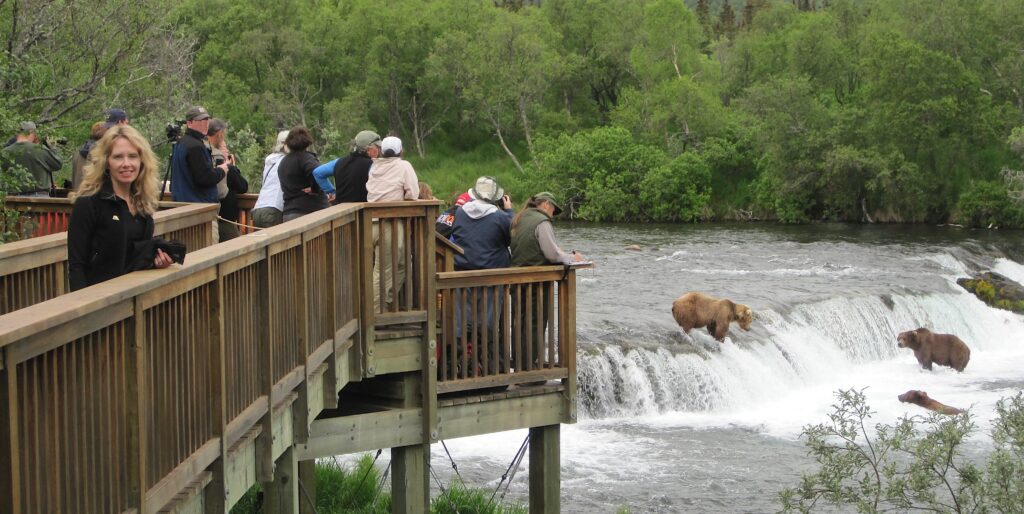
A short walk from the lodge brought us to the mouth of the river. The first viewing platform is on the other side; a floating footbridge lets humans cross the river while bears can swim under the bridge or walk around it on shore.
Karen and I crossed the river and went to the top of the first platform. It had a panoramic view with Brooks River on one side and the lake on the other, but there were no bears. After a few minutes and many mosquito bites, we decided to keep walking; our destination was the Falls Platform.
The ranger on our platform was standing at the gate. When we approached the gate, he said, “I need you to stay here. There’s a bear in the area.” The rangers all have radios to report bear sightings and movements to one another. Our ranger heard a bear was heading toward us, and he was holding everyone on the platform until the bear passed.
We looked in the direction of the river and then toward the lake; we saw nothing. Everyone on the platform was searching, and hoping to be the first to spot it. I thought it was a false alarm, but we politely stayed on the platform. It was our only option since a ranger was blocking our exit.
Our first encounter with a brown bear
A few minutes later, I was looking in the direction of the trail to the Falls Platform – the trail we were about to walk down – and coming out of the trees no fewer than 100 feet away was the biggest bear I’ve ever seen, zoos included. I think I felt the ground shake as he walked past us – it could have been my imagination.
Once the bear walked a few hundred feet toward the lake, and was clearly moving away from us, the ranger opened the gate, stood aside, and gave us a smile. Before leaving the platform, I had a silent chat with myself that went something like, “Wait… Wait a second… A fur-covered Volkswagen just walked out of the woods on the trail we’re now going to walk down. What if… what if we would have walked down that trail a few minutes earlier? What would we have done? What if that isn’t the only bear in the woods?”
I had no answers to my questions. I’d already forgotten everything they told us in bear school. Were we supposed to look at the bear but don’t talk to it? Run at a diagonal then climb a tree? I hesitated at the gate and asked the ranger, “Is it okay for us to walk to the Falls Platform?” I was pointing to the trail that thunder paws just came from.
“Oh yeah, just watch for bears,” he said.
“But, had we not stopped here first, we would have been walking right toward that one. And, that’s okay?”
He was searching for my bear school pin when he asked, “You’ve been through bear orientation haven’t you?”
“Yes we have, but, here’s the part that worries me a little, I don’t think a 20-minute bear talk is enough preparation for meeting a bear that size in the forest.” (I wasn’t really paying attention in bear school. I thought there would be cookies afterward; I spent most of the time looking for the treat table.)
The ranger said, “If you see a bear, keep your distance, move away slowly, talk to it, don’t make eye contact, give it plenty of space, so it can walk past you. You’ll be fine. It helps to get behind a tree.”
I didn’t laugh this time.
A walk through the woods to the platform
It was a half a mile hike through the forest from where we were to the Falls Platform. We walked briskly, like when I was a kid and had to retrieve my Frisbee from the neighbor’s yard – the one with the German Shepherd – hoping the dog didn’t see, hear, or smell me before I jumped back over the fence.
At the end of the trail, there was a raised boardwalk with a heavy gate. Once through the gate, we felt safe again. The boardwalk led to both the Falls Platform and Riffles Platform. Falls Platform is the prime bear viewing spot. It’s closest to where the bears congregate to fish for salmon. During salmon runs, usually there’s a waiting list for the Falls Platform.
There’s only room for about 40 people at one time. We put our names on the list, and the attending ranger told us the wait might be as long as an hour. The park service limits each stay on the Falls Platform to an hour, but you can put your name back on the list as soon as your time is up. It’s less of a hassle than it sounds. We waited on Riffles Platform with the other visitors.
The ultimate fishing spot for the bears is right at the falls. Salmon collect in the pools at the foot of the falls, gather their energy, and take flying leaps to get over the rapids. It usually takes several tries to make it. I doubt there’s a salmon that made it to the spawning grounds of Lake Brooks that hasn’t felt the breath of a bear on its dorsal fin, perhaps several times.
It’s feeding time
The bears here spend up to six months every winter hibernating. They don’t eat year-round. When not sleeping, they need to eat as much as possible to store huge amounts of fat, or they might not survive. Fishing is a matter of life or death. It is no surprise that the bears don’t have a waiting list for who gets to fish at the primo locations. The biggest meanest bears get the best fishing spots, and they stay there as long as they want (or until another bear pushes them out).
We noticed that not all the bears were catching the same amount of fish; a small percentage of the bears caught a large percentage of the salmon. Looking down river from the falls, we saw a perfect map of the local bear hierarchy. The farther you get from the falls, the smaller, younger, and less experienced are the bears.
Down at the Riffles Platform it was the minor leagues. Younger bears – maybe three or four years old – were lunging at fish, burning huge amounts of calories splashing with wild fury, and ending up with nothing to show for their efforts. After a few minutes of flailing, they would sit on a boulder in the middle of the river, half resting and half confused at why the flashes of color in the water were so hard to catch.
As entertaining as this was to watch, it was serious business; survival for these bears depends on getting the most calories for the least calories spent. Young bears may have playful energy, but they cannot afford to splash around all day and not have anything to eat. The faster they learn to fish, the better their chances of thriving, or surviving.
We made it to the big leagues
Soon enough, it was our turn on the Falls Platform. Every inch of the upper and lower deck railing was occupied when we got there, but within a few minutes, a spot opened at the far end closest to the falls. Karen and I scored a prime location, and no one tried to kill us – another advantage of being at the top of the food chain. My digital camera looked silly compared to the cameras the others were using.
The platform looked like a paparazzi gathering; half the group looked like professional photographers, or at least very serious amateurs. When you see a picture in a magazine, web site, or travel brochure of a brown bear standing at the top of a waterfall with salmon jumping through the air, that picture was more likely than not taken from the Falls Platform.
For the most part, the behavior on the platform was civil. Even though it was crowded, people made room for one another so they could have a front row view. Every few minutes, the ranger would come through with her clipboard and tell people that their time was up. The couple next to us acted like they couldn’t understand the ranger when it was their time to leave.
Finally, the wife acknowledged the ranger and headed toward the exit. Her husband followed for a few steps, but then came back, and sat down at my feet between my legs and the end railing. He waved to his wife to go on. When the ranger got to the gate, she looked around, and seeing only the wife shrugged her shoulders and put her hands out, palms up, in a show of frustration as if to say, “Where’s your husband?”
The couple apparently didn’t speak English. The wife said, “No. No.” The ranger marched back to the platform, and found the husband hiding behind me. She came over to him, put her face close to his, and pointed her thumb toward the exit. He said, “No. No.” She wasn’t falling for the “I can’t understand what you’re saying” trick; she’d seen it all before. She booted him off the platform.
So many bears!
During the hour we were on the platform, I used as much memory on my camera’s data card as all our previous parks trips combined. In one shot, I counted nine bears in the picture frame. Downstream, there were many others. All the bears at the falls were big; the biggest of the bigs, but one seemed to be the alpha bear. He sat in a pool below the falls with his entire body underwater except for his head.
At first, this didn’t look like the best way to catch fish, but soon it was clear that it was. The other bears were lucky to catch a fish an hour; the alpha bear caught six or seven while we were on the platform. Salmon would gather in the pool at his feet preparing to make their leap. When one would graze his leg, he would dive beneath the surface and come up with it in his mouth.
A few yards downstream he ate his catch. In four to five minutes, he would eat a six-pound salmon and then return to his fishing hole. The other bears would try to sneak into the hole when the alpha bear was eating. They did so at considerable risk; the alpha bear had visible scars on his face and neck. A furless patch on his shoulder was still bleeding from a recent run-in with another bear. He was constantly defending his spot. As soon as the alpha bear gave the slightest indication he was ready to return to his fishing spot, the other bears hastily cleared away.
The old man bear
A short distance downstream from the falls was a small island in the river. Sitting on the island, crouched over, breathing heavily, and with his front lip hanging loose touching the ground was a very old bear. Karen called him the old man bear. He was huge; his frame was larger than the bears fishing at the falls, but that’s all there was – bones and fur. He looked like he was wearing a brown bear fur coat three sizes too large.
The park service has a database of every bear in the park. They know how old each bear is, who’s related to whom, what part of the park they hang out in, etc. The ranger on the platform said the old man bear was 30 years old. That’s very old for a brown bear. He couldn’t fish anymore and he moved slowly; even so, the other bears gave him a wide berth as if they had encounters with him in the past that didn’t end well. They didn’t want to find out if there was any fight left in this slow moving bag of bones.
Karen asked the ranger if they ever help bears in distress. The ranger said they don’t intervene in the natural process, no matter how painful it is to watch. Even when a small cub is being attacked and killed by a larger bear, they’re not allowed to interfere.
The old man bear didn’t look as if he would make it one more winter, or even to next winter. The ranger said most bears in his condition go into hibernation and don’t wake up the next spring. He sat on the island watching the alpha bear fish. When the alpha bear would catch a salmon, he’d walk close to the island and eat the fish right in front of the old man. He’d eat most of it, and then leave the last couple of bites in the river for the old man bear.
There was no mistaking he did this on purpose. The alpha bear was feeding the old man. We saw this happen a few more times. He let only the old man bear eat his scraps; none of the other bears were allowed to come close.
The forest was filled with bears
When our time on the platform was up, we were ready to take a break from the mosquitos and head back to the lodge. But here’s an important point to make: the bears weren’t just in the river; the forest was also filled with bears, more so as we were leaving than when we arrived at the platform. As we walked to the end of the boardwalk, where the heavy gate separated us from the rest of the park, we kept seeing very large bears just under and near the boardwalk.
It became frightfully obvious that just because the boardwalk extended a couple of hundred yards away from the river, the gate didn’t indicate the beginning of a safe zone. The bears we just saw in the river walk through the same forest, and sometimes on the same trails, as the visitors. “It’s a bear highway,” Karen said. Exiting through that gate felt as if we were walking into a zoo, the inside part where the animals live.
Have you ever been to the MGM in Las Vegas where they have lions in a glass enclosure next to the casino? Imagine the glass gone, but the lions still there. Now imagine that every so often a lion strolls through the casino, between the craps tables and past the Wheel of Fortune; terrified guests back up diagonally and stand behind slot machines. That’s what Katmai is; except with bears instead of lions, and wilderness instead of a casino.
If Karen was on edge walking back to the lodge, I was on the edge of the edge. The only thing that kept me from panicking was the fact that other people were walking on the trail with us: old people, families with young children, rangers… It really took a while for me to accept that the park service allows people and bears to be so close to one another.
Halfway back to the lodge, Karen stopped at the restrooms along the trail. I was facing toward her and away from the trail when she came out. She took one step out of the restroom and gave me a startled look – like she just realized she dropped her cell phone in the pit toilet. She gasped and said, “There’s one!” I turned around and saw a hump of brown fur moving through the trees about 30 feet away. We both turned and ran.
She gasped and said, “There’s one!” I turned around and saw a hump of brown fur moving through the trees about 30 feet away.
A few steps into our sprint we stopped as our brains remembered the number one lesson from bear school – never run from a bear. We stood and watched the bear silently amble through the forest. He no more wanted to chase us than we wanted him to. Once he moved to a safe distance, we continued on to the lodge.
They can be anywhere. And they are.
Next to the dining area in the lodge’s main building is a round fireplace with chairs circling it. Most of the day-trippers had left; campers and overnight lodge guests were all who remained. At the lodge’s small bar we got a beer, sat by the fire, and started a conversation with the couple sitting next to us. By the second round of beers, it was time for me to find a restroom.
I only share this detail with you because there is no restroom in the main building, so I had to go outside to a separate building a short distance away. I walked out the front doors of the lodge, turned right to head toward the restrooms, and guess what came out of the bushes right in front of me? A bear. A big one. I didn’t run, nor did I pee myself. Although, it was a close call considering I had to pee in the first place. The bear sauntered off without incident. I took care of business and re-joined my foursome around the fire.
The three of them were deep into a conversation. At a pause, I announced that I ran into a bear while going to the restroom. They looked at me briefly, and the husband said, “Yeah, they’re all over,” and went back to the conversation. That’s Katmai. Running into a bear while going for a pee is no big deal.
That one ranger scared me more than the bears
After dinner, we decided to take a walk around the lodge area: the beach, visitor center, and campgrounds. The weather was good, and this being our only night in the park, we wanted to see as much as possible. Earlier in the week, we got plastic cups at the Denali Backcountry Lodge. They were grown-up sippy cups with plastic lids to keep from spilling. We had a bottle of wine with us in our room, and Karen said, “Let’s put wine in our Denali cups and take them with us on our walk.”
I replied, “That’s not allowed in the park, only water.”
She looked at me with contempt and said, “I don’t think the bears are interested in Sauvignon Blanc.”
Going against my better judgment, I went along with Karen’s plan. We put on our jackets and backpacks, poured the wine into our sippy cups, and headed toward the visitor center. We hadn’t walked 30 feet from our cabin when we heard, “Folks, what do you have in your cups?” A ranger – the authoritative looking one with the gun – headed straight toward us.
She scared me more than the bears. We were so busted. She didn’t even wait for our mumbled responses. She knew what we were trying to pull. She barked, “I need you to go back inside with your drinks. Thank you.” With a, “Yes ma’am” we spun around and slinked back to our cabin. I was kind of hoping Karen would sass her, but she didn’t.
This morning after breakfast in the lodge, we hiked to Brooks Lake. We were surprised not to see any bears. On our way back, we stopped for another hour on the Falls Platform. The same show was playing as yesterday, only this time there were bears on top of the falls trying to catch salmon as they leaped through the air. I read on the park’s website that not all visitors to the park see bears. That was a surprise considering we saw, without exaggeration, at least 100 bears in our day and a half visit. It all has to do with timing; when the salmon run the bears will be at the river.
Mama and her cubs paid us a visit
From the Falls Platform, we hiked back to the lodge for lunch. When we passed the ranger at the mouth of the river, there was a lot of chatter on her radio. I heard, “Where did you see her last?” and, “Where are they now?” Several rangers were walking quickly between the river and the lodge. We were walking toward the lodge when a slightly frantic voice from behind us said, “I need all you folks to stay where you’re at.”
There were eight to ten of us on the trail. The ranger came over and said, “Let’s all move up on this hill and stand together.” (The hill was a small grassy area in front of the gift shop.) The ranger turned her back to us and walked a few yards down the trail. Just then, a large mother bear walked out of the tall grass along the trail; very close behind her were two young cubs, then a third popped out of the tall grass. Number three was half the size of the other two. An audible “ahhhh” came from the group when the little one scurried to catch up.
The mother and two larger cubs paid no attention to the ranger or us. They kept their heads down, walked along the trail, and cut through the trees toward the beach. The runt gave us a look like he’d rather check us out than follow his mother. The ranger gave the little one a stern arm gesture pointing toward the mother bear. Karen said, “Oh, he looks like a little monkey.”
He was cute for sure. I told Karen he doesn’t have a good chance of surviving being so small and having two larger siblings. She said, “Don’t say that! The mother will love him more because he’s small.” I’m not sure it works that way with bears, but there was no use explaining that to Karen.
Mother and cub family groups are extremely cautious near Brooks River because the large male bears will try to kill the cubs. This is why they spend more time around the lake and lodge than the river. A mother bear has three main jobs: keep other bears from killing her cubs, feed them, and teach them to fish. But here’s her problem: she can’t fish where it’s easy because the bigger bears will run her off or kill her cubs, and fishing downstream is difficult, so she might spend all day fishing and end up catching nothing. It’s a small wonder that any cubs make it to adulthood, even in a place with so many fish.
The white board in the lodge office said we were on the 5:00pm flight to King Salmon. That was not enough time for another trip to the falls, so we hung out around the lodge and walked along the beach. In the afternoon, the beach is a busy place: people standing around waiting for their flights, new visitors taking a first look around, even bears passing through.
They will chase you
Karen and I were standing on the beach with a handful of other visitors. We were about 100 yards from the visitor center. A quarter mile away was a bear slowly walking toward us along the water’s edge. The beach is a passageway for bears. They come down from Brooks River and follow the beach around the bump out of land in front of Brooks Camp to get to their permanent habitat. The bear walking toward us was in no hurry. Every few yards he would wade into the water, turn over a rock, paw at something that looked like food, and then continue moving toward us.
The rule is you’re not supposed to be within 50 yards of a bear; that’s of course if you see the bear soon enough to give it space. It was obvious in this case that we should move away as the bear approached. I’m not exactly sure how far 50 yards is. I know it’s half the length of a football field, but it’s a guess really when a bear is walking toward you.
The bear finally got close enough that Karen and I started backing up toward the visitor center. There was a man and his teenage son between us and the bear. The father and I were both taking pictures of the bear when I said, “I think we should get back to the visitor center.” As the father turned toward me, a lens fell out of his camera bag onto the beach. He bent down to pick it up while I watched the bear. I said to him, “You need to hurry. The bear is looking at us.”
The father grabbed the lens, and as he stood up everything else fell out of his camera bag and onto the beach – another camera, a couple of lenses, it was a lot of stuff. I said, “Just leave it!” But he frantically tried to gather his gear. Meanwhile, the bear kept looking at us from the lake. I became genuinely concerned for this guy. I instinctively ran a few steps toward him to help him pick up his stuff.
Now, here’s a tip I learned that they don’t teach you in bear school. A tip, I realize, most people don’t need to be told, but I suggest the park service add it to their curriculum. The only thing worse than running from a bear is running at a bear. What our lake bear saw was not me running to help a fellow human. No, the bear saw me running at him. I looked up from our crouched position and saw a very large, and from all appearances angry, bear running full tilt toward us. I grabbed the guy, and we did the second dumbest thing we could do, we ran away from the bear. Karen was a few feet ahead of us this whole time.
I’ve always thought I could outrun Karen if I had to, but here’s something else I learned today: when a bear is chasing us, Karen is quicker than me. She ran like, well, like an angry bear was chasing her. I had no chance of catching her.
We all ran toward the visitor center (because bears aren’t allowed in the visitor center). I thought the bear might pull up after a few yards, but when I looked back he was still coming at us. I scrambled up the path that led away from the beach to see a wall of people desperately pushing their way into the front door of the visitor center. The visitor center was no longer an option for me. Glancing at the electric fence, I decided in an instant I couldn’t make it there in time. All that came to mind at that moment was – shit! Just then I heard someone in the crowd say the bear veered off and was now running down the beach away from us. I don’t know how close he got to us, but it was too close.
Later Karen said the bear was only chasing us for fun and would have never attacked. Interesting. That must be why she ran like an escaped convict.
We’re back in Anchorage now, safely inside our hotel room. There are no bears in the parking lot or in the bushes next to the front door. It feels – tame. But not for long. Tomorrow we head back into the bush, to Lake Clark National Park.
Your friend,
Matt
